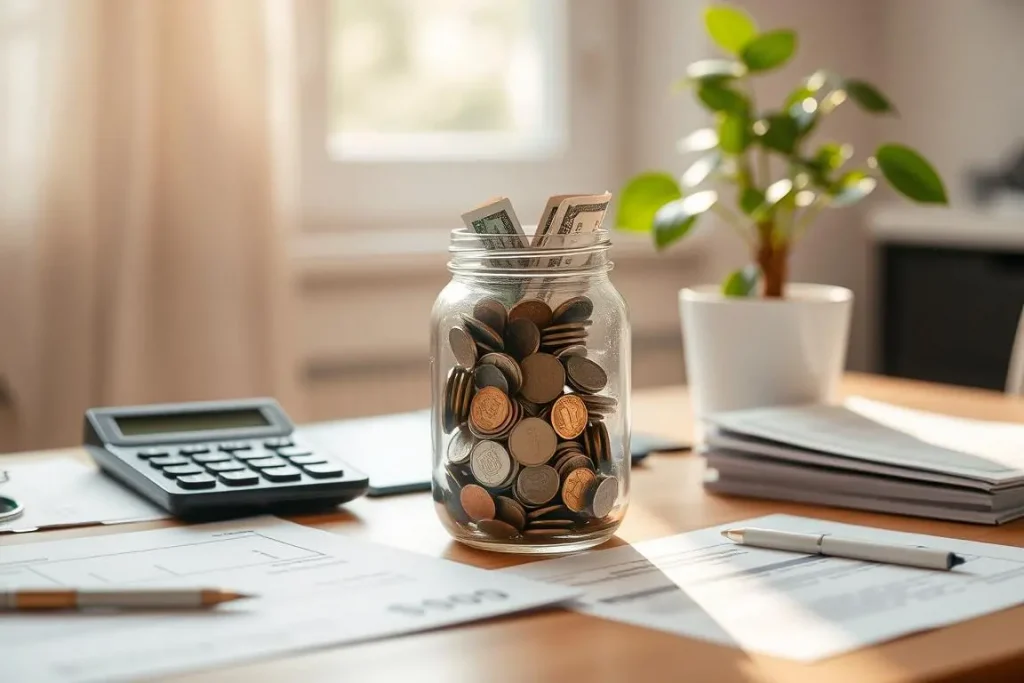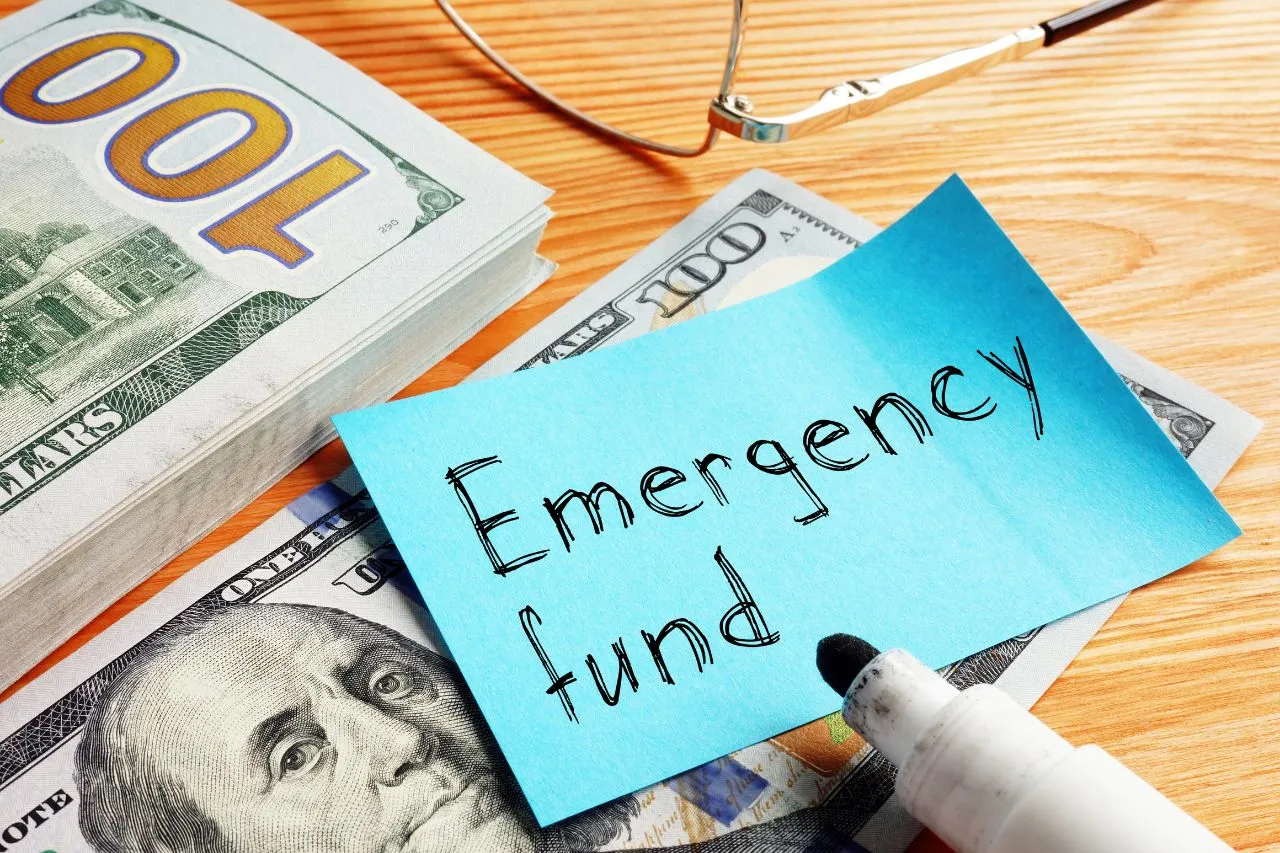Creating a strong emergency fund is key to financial stability and security. This guide offers expert advice and steps to build a safety net. It helps you handle unexpected costs and life’s surprises. Whether you’re starting to save or want to improve your fund, this guide has what you need to secure your financial future.

A serene and organized tabletop with a glass jar filled with cash and coins, surrounded by financial documents, a calculator, and a potted plant for a touch of greenery. Soft natural light filtering through a window, creating a calm and inviting atmosphere, symbolizing financial security and preparedness.
Key Takeaways
- An emergency fund is essential for financial stability and peace of mind.
- Determine the right savings goal based on your personal circumstances.
- Automation and additional income streams can accelerate your savings.
- Preparing for unexpected expenses helps you weather any financial storm.
- Building an emergency fund is a crucial step towards financial security.
Why an Emergency Fund is Essential
Building an emergency fund is key for financial stability. It acts as a financial safety net. This helps you handle unexpected costs in life.
Unexpected Expenses and Financial Stability
Life is full of surprises, some good, some not. Expenses like medical bills or car repairs can throw off your budget. An emergency fund helps you cover these costs without debt or using long-term savings.
Peace of Mind in Times of Uncertainty
An emergency fund does more than just protect your money. It gives you peace of mind. With a financial plan, you can focus on life’s challenges without worrying about money.
Job loss, medical emergencies, or big home repairs can be tough. An emergency fund gives you the financial stability and peace of mind you need. By building this financial safety net, you’re ready for any unexpected expenses ahead.
Determining Your Emergency Fund Goal
Building a strong emergency fund is key to a secure financial future. But, you might wonder, “How much should I save?” The answer depends on your specific situation and financial goals. We’ll help you set a realistic emergency fund goal that fits your needs.
To figure out your emergency fund goal, look at your monthly bills and possible risks. First, list your must-have monthly costs like rent, utilities, groceries, and other essential expenses. Try to save enough to cover 3-6 months of these costs. This will help you in case you lose your job, face unexpected medical bills, or other financial crises.
- Calculate your monthly essential expenses
- Multiply this amount by 3-6 to determine your emergency fund target
- Consider additional factors like job stability, health concerns, and financial goals
- Adjust your target as needed to ensure it meets your unique circumstances
Having a clear emergency fund goal helps you make a plan and start building your financial safety net. The aim is to have money set aside for unexpected expenses and to keep your finances stable during tough times.
“An emergency fund is the foundation of a solid financial plan. It provides peace of mind and a safety net when life throws curveballs your way.”
Reviewing and Adjusting Your Goal
As your financial situation changes, it’s crucial to check and tweak your emergency fund goal. Changes in income, expenses, or family size might mean you need to reassess your target. By keeping an eye on your finances and adjusting your how to build savings plan as needed, you can make sure your emergency fund stays a solid financial safety net for the future.
Strategies for Building Your “emergency fund guide, how to build savings, financial safety net”
Building a strong emergency fund is key for your financial health. It can be tough to save and grow your savings. But, there are ways to make it easier and more effective.
Automating Savings and Budget Tracking
Automating your savings is a smart move. Set up automatic transfers from your checking to a savings account. This way, you save a part of your income before you spend it. Also, use budget tools to track your spending and find ways to save more for your emergency fund.
Side Hustles and Extra Income Streams
Side hustles or extra income can really boost your emergency fund. Look for jobs that match your skills and interests, like freelancing or selling online. Putting this extra money into your emergency fund can speed up your savings.
| Strategy | Benefit |
|---|---|
| Automating Savings | Ensures consistent contributions to your emergency fund without the risk of forgetting or procrastinating |
| Budget Tracking | Helps you identify areas where you can cut back on expenses, freeing up more funds for your emergency savings |
| Side Hustles | Generates additional income that can be directly channeled into your emergency fund, accelerating your savings |
Using these strategies, you’ll be on your way to a solid “emergency fund guide, how to build savings, financial safety net”. This will give you financial stability and peace of mind.
Creating an emergency fund guide is key to securing your financial future. This guide shows you how to build a financial safety net. It gives you peace of mind and financial stability for unexpected challenges.
Consistent and disciplined how to build savings are crucial. They help you build a strong emergency fund. This is important for reaching your financial goals.
Unexpected medical bills, losing your job, or big home repairs can happen. A well-funded emergency fund helps you handle these surprises. By saving and using the strategies in this guide, you can control your financial future. You’ll get the financial security you deserve.
So, what are you waiting for? Begin building your emergency fund guide now. Take the first step towards a more secure financial future. With hard work and discipline, you can change your financial situation. You’ll have a strong financial safety net for the future.
FAQ
What is an emergency fund and why is it important?
An emergency fund is money saved for sudden costs like medical bills or car repairs. It’s key to have one to avoid debt when money is tight. It also brings financial stability and peace of mind.
How much should I save for an emergency fund?
Aim to save 3-6 months’ expenses for emergencies. But, this can change based on your job security, health, and other financial needs.
How can I build my emergency fund?
Building your fund can be done through:
– Automating savings by setting up regular transfers
– Cutting costs and saving the difference for emergencies
– Increasing your income and putting extra earnings towards your fund
Where should I keep my emergency fund?
Keep your emergency cash in a high-yield savings or money market account. This way, it earns interest and is easy to access when needed. Don’t risk it in risky investments.
How do I know when to use my emergency fund?
Use your emergency fund for real, unplanned expenses like medical bills or job loss. Don’t use it for non-essential spending or planned costs you could save for.
What should I do after using my emergency fund?
After using your emergency fund, start rebuilding it quickly. Adjust your budget, cut expenses, and add any extra money to your savings. This keeps you ready for future financial surprises.

